Evergreens are important Xeriscape plants for Colorado landscapes. Since lawn areas are often limited in Xeriscaping design, evergreen plants can step right in to provide rich green color all year long.
Evergreen plants also provide great contrast with other plants, particularly with the the foliage and seed heads of ornamental grasses, and as a backdrop for flowering shrubs and perennials. And evergreens can often be utilized to effectively create privacy and screen or block undesirable views in the landscape.
I am limiting this top 10 list to evergreen shrubs. Another very interesting category of plants are the so called “semi-evergreens”, which are deciduous plants that keep all or part of their foliage throughout the winter. I will do a future list of the top semi-evergreen Xeriscape plants. I am also excluding large trees from this list, as they are a category unto themselves and many people are already familiar with evergreen tree choices.
Although this is a Colorado list, most of these plants can be used in many places throughout the world depending on the local climate.
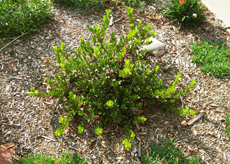
- Panchito Manzanita – Arctostaphylos x coloradoensis ‘Panchito’ Panchito Manzanita is a low growing woody shrub with shiny, oval, dark green leaves that persist throughout the winter. It gets small, pale pink flowers followed by small red berries- but it’s best characteristics are the evergreen foliage and the fact that it requires little care or water. The only time I have had an issue with this plant was when it was placed in an area with very poor soil and poor drainage- even then, the plant looked healthy, it just didn’t get any larger.
- Kinnickinnick – Arctostaphylos uva-ursi Since the Mock Bearberry and Panchito Manzanitas have become some of my favorite plants, I started taking a second look at their cousin the Kinnickinnick. This plant has been around for a long time and thrives in the eastern U.S. Here in Colorado, it needs full to partial shade and requires a little more water. It stays a little smaller than the other Manzanitas, but since there are so few evergreens that thrive in shade it is an invaluable plant.
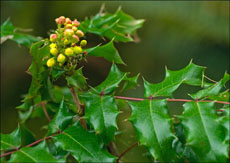
- Oregon Grape Holly – Mahonia aquifolium I consider Oregon Grape Holly to be an evergreen plant, even though that may not be botanically correct. It has large, glossy leaves that persist through winter, turning bronze-red, and gets clusters of small yellow flowers in the spring. It can handle a ton of different conditions, from partial sun, through full shade, and doesn’t seem to mind the toughest clay soil. This plant is a true staple of the Colorado Xeriscape. Oregon Grape Holly gets about 4-6 feet wide and tall, with the “compacta” variety staying about half of that size.
- Yucca – Yucca ssp. Native to the Southwestern United States and Mexico, Yuccas are another plant that is not generally thought of as an evergreen. But they are just about the perfect evergreen plant for a Xeriscape! Yuccas provide really good steady green foliage that can blend in with other plants or be used as a statement with it’s unique form. A tall stalk of white flowers appears in summer to make these plants all the more interesting. All that, from plant that is native to Colorado and requires no maintenance or no supplemental watering! Note: Red Yucca is another great plant that gets red flowers instead of white. It’s scientific name is Hesperaloe parviflora.
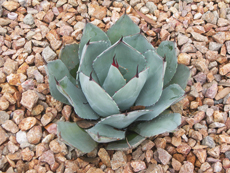
- Agave – Agave parryi Agaves are very similar to Yuccas, and provide many of the same benefits. They tend to grow slower, and are a little smaller, so I recommend using them closer to pathways so their foliage can be enjoyed. Agaves only flower once every 25 years, sending up a very tall flower stalk. After they flower, the parent plant dies, and is replaced bu suckers from the root.
- Dwarf Globe Blue Spruce – Picea pungens ‘Glauca Globosa’ Most people would not consider this a true Xeriscape plant, but I am including it because I have had very good luck with these plants in Xeriscapes. Being a spruce, they do require a little more watering until they are established. However I have seen these plants used in low water use landscaped on the same drip zone as true Xeriscape plants and they have thrived. The blue color and the fact that they stall relatively compact are characteristics that cannot be found with any other plants that I am aware of.
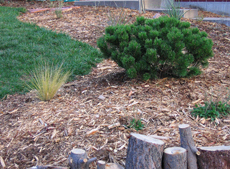
- Mugo Pine – Pinus mugo ssp. Mugo pines can provide very good dark green color, and are perfectly adapted to Colorado’s climate. They are a perfect accent to boulders and flowering perennials. Be sure to give them plenty of room, they are slow growing and are usually pretty small at the time of planting- however most of the varieties will get quite large over time.
- Spreading Junipers – Juniperus horizontalis ssp. Junipers have been given a bad name, as we have written about before, but creeping or spreading junipers require little maintenance and can be very valuable parts of a well designed Xeriscape. These plants work well when mixed with a variety of flowering and deciduous plants and grasses. They can provide good ground coverage and green color to break up large mulch areas and as understory between shrubs. Varieties such as “Youngstown” and “Blue Chip” offer a variety of green to blue-green hues.
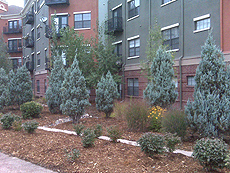
- Upright Junipers – Juniperus scopulorum ssp. These upright shrubs can work well as vertical elements in a Xeriscape (as seen above), or to provide screening of utility areas. Some of the varieties stay very narrow, which can be invaluable in tight spaces where evergreen trees would get far too wide. Be wary of limb breakage in very heavy snows, especially with very narrow varieties such as “Skyrocket”. Junipers are native to Colorado and require very little water, care, or maintenance.
- Compact Tanyosho Pine – Pinus densiflora ‘Globosa’ Compact Tanyosho Pine is a unique large shrub or small tree that has a very nice dark green color and requires minimal maintenance. It is one of the rare evergreen trees that stays very compact, yet requires little water unlike many of the other dwarf conifers. It also has an interesting form, with one or multiple bare trunks at the base with the needles forming a mound at the top.
This is the official blog of Outdoor Design Group, Colorado Landscape Architects. For more information about our business and our services, click here.
Thanks for the great info, Matt – I learned so much! I am moving here from the midwest and boy am I going to miss just sticking anything in the ground and watching it grow automatically! At least I now know there are many options for a beautiful landscape out here. I’m getting a house in Manitou Springs and am particularly interested in tall potted trees/plants that I can use on the side of my deck to get a little privacy from the verrry close neighbors in lieu of a fence. Any suggestions? I was looking at your beautiful portfolio of residential landscapes and saw a tree in a yellow pot and was wondering what that was and if that may be an option for me as well? Thanks again for your fantastic site and advice.
Thanks for the comment Linda. Potted plants are a little trickier in our climate, they may not survive winter or the pots may be damaged by freeze/thaw. Do you have room to the side(s) of your deck to plant some columnar evergreen and deciduous plants at ground level?
What do you recommend for a small yard that provides privacy Year round? It’s a small yard so I’d like to be able to growth something under it or nearby.
Hi Amanda, thanks for your question. We would need to know the following info at a minimum in order to answer best:
1) Where is the site located (City and State)
2) How much watering will it receive aside from natural precipitation?
3) How much sun does this area of the yard get? Full sun, part sun, or full shade?
4) How tall and how wide of a plant would you like? Do you need it to be evergreen if you would like year-round privacy?
Thanks!
Hi Matt, Thanks for the information. I live in the Front Range of Colorado and have a planter as part of a wall in my front yard. It’s roughly 4′ by 3′. I would like to plant something that is easy to care for (there will be a sprinkler attached) and would provide some height for privacy, maybe be 3-5′ tall. The area gets full sun most of the day. Any suggestions? TIA
How do I move a mugo pine? I have several that have grown since planted before we bought out home. They are choking out the boxwoods.
If the mugo pines aren’t too big, dig them up, keeping as much of the root ball as possible and replant them in a new location where you’ve dug a hole that is twice as wide as the root ball of the mugo pine. Place the top of the root ball 1″ higher than the grade of the surrounding bed. Backfill the hole with the soil that was dug out of the hole, but mix in some compost to that soil before placing back in the hole. Give the newly transplanted mugo pine a good watering once you’re done. It is best to do any planting or transplanting of shrubs during cool and wet weather. If it is too hot or dry, your shrubs will be stressed and will not transplant well. Cool spring and fall days or evenings are the best times to do any planting or transplanting.
I am looking for an evergreen bush, that is low maintenance that I can plant in the cemetery. We live at around 6000 ft. and the cemetery is very flexible on what we plant. I want something that will stay small, three feet or less, and not very fat. I was thinking a holly bush